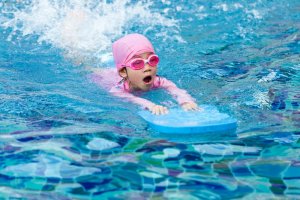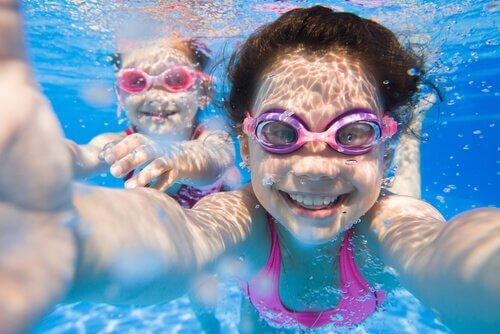The Best Tips for Teaching Children How to Swim


Reviewed and approved by Doctor Carlos Fabián Avila
Swimming is one of the healthiest and most complete exercises you can do. It works almost all of the body’s muscle groups, and can also be an excellent and playful activity. Sharing moments with family and friends in the pool is an experience that will be remembered for life. In today’s article, we’ll share some guidelines for how to teach your children how to swim.
Discover the easiest and safest tricks to get your kids to enjoy swimming. Through games, discipline, and some information about the precautions you should take, they’ll learn to love this particular sport.
Teach Your Children to Swim without Fear
The first obstacle you may run across when it comes to teaching your children how to swim is fear.
To overcome this, we suggest you begin to get them used to the water as early as possible. The goal is to normalize the situation so that their first encounters in the water are with their parents. This will help them build confidence so they can relax and enjoy the activity.

One way to help your child feel safe is to practice with very little water. Start out in a shallow pool where they can stand and not worry about sinking. It’s also important that the water be warm because their skin is more sensitive, and you want them to be physically comfortable.
With their parents by their side, they’ll be ready to begin.
Discover: 5 Children’s Books they Should Read before Turning 6
Breathing Exercises in the Bathtub
A bathtub at home is the ideal location for the first lessons on breathing. Holding their nose and blowing bubbles underwater is a good start to get them used to breathing around a body of water.
The bathtub can also be the first place they submerge their head under water and experience that sensation. A fun game might be to encourage them to find a toy at the bottom of the tub. Learning by playing is always the best way to start a new activity.
However, you should never try to force your child to submerge their head under water. Their learning should be a natural and gradual process over time. Some children are braver and more carefree, while others are a bit more cautious in the water.
Either way, they can all become great swimmers if you know how to respect and motivate their learning process.
Little by Little in the Pool
The first contact in the pool to teach your children how to swim will likely be sitting on the edge and dangling their feet in the water. This will help your child become used to the temperature of the water and they can try paddling or kicking a little.
After a while, you can persuade them to get in the water with you and hold them at all times, taking them to a place where they can stand and walk in the water.
One tip that has been shown to be effective is to minimize the use of floats. Floats typically create a dependency that’s hard to break later on. In addition, they provide a false sense of buoyancey and security while swimming.
Do not miss: 4 Tricks to Remove Water from Your Ear
The First Movements
Your child should understand that swimming is fun, so never get angry if they don’t want to complete an exercise. The first few times in the water should be presented in the form of a game, depending on their age and abilities.
- Between the parents: Hold your child between two adults a short distance apart and gradually increase the distance while passing them between the two of you. Your child will instinctively start to perform their first swim strokes.
- Search for a prize: Hold your child in the water horizontally. Encourage them to try to reach for a toy. You can start by placing the toy very close to them and gradually increase the distance.
- Airplane: Your child can hold onto your neck from behind, while you extend your arms like an airplane and “fly” them through the water.
These tips and exercises will help your children learn to swim so they can start to enjoy this fun and healthy activity.
All cited sources were thoroughly reviewed by our team to ensure their quality, reliability, currency, and validity. The bibliography of this article was considered reliable and of academic or scientific accuracy.
- Coto Vega, E. El proceso de enseñanza y aprendizaje de la natación en niños de 2 y 3 años. InterSedes: Revista de las Sedes Regionales [Internet]. 2002;III(5):61-73. Recuperado de: https://www.redalyc.org/articulo.oa?id=66630506
- Latorre García Julio, Sánchez-López Antonio Manuel, Baena García Laura, Noack Segovia Jessica Pamela, Aguilar-Cordero María José. Influencia de la actividad física acuática sobre el neurodesarrollo de los bebés: revisión sistemática. Nutr. Hosp. [Internet]. 2016 [citado 2018 Dic 16] ; 33( Suppl 5 ): 10-17. Disponible en: http://scielo.isciii.es/scielo.php?script=sci_arttext&pid=S0212-16112016001100002&lng=es. http://dx.doi.org/10.20960/nh.515.
- Latorre García, Julio, Sánchez-López, Antonio Manuel, Baena García, Laura, Noack Segovia, Jessica Pamela, & Aguilar-Cordero, María José. (2016). Influencia de la actividad física acuática sobre el neurodesarrollo de los bebés: revisión sistemática. Nutrición Hospitalaria, 33(Supl. 5), 10-17. https://dx.doi.org/10.20960/nh.515
- Swim England Learn to Swim Framework Stages 1-7. Swim England. https://www.swimming.org/learntoswim/swim-england-learn-to-swim-framework/
- Learning through play. 2018. UNICEF. https://www.unicef.org/sites/default/files/2018-12/UNICEF-Lego-Foundation-Learning-through-Play.pdf
This text is provided for informational purposes only and does not replace consultation with a professional. If in doubt, consult your specialist.








